Cuisinart DLC-8S User Manual
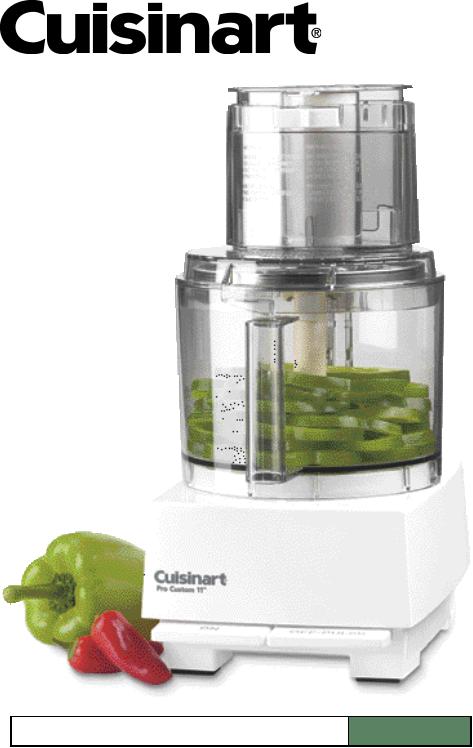
INSTRUCTION AND RECIPE BOOKLET
For your safety and continued enjoyment of this product, always read the instruction book carefully before using.
IMPORTANT SAFEGUARDS
Always follow these safety precautions when using this appliance.
Getting Ready
1.Read all instructions.
2.Blades are sharp. Handle them carefully.
3.Unplug from outlet when not i n use, before putting on or taking off parts and before cleaning. To unplug, grasp plug and pull from electrical outlet. Never pull cord.
4.Do not use outdoors.
5.Do not let cord hang over edge of table or counter, or touch hot surfaces.
6.Do not operate any appliance with damaged cord or plug, or after appliance has been dropped or damaged in any way. Return appliance to the nearest authorized service facility for examination, repair or electrical or mechanical adjustment.
Operation
1.Do not use pusher assembly if sleeve becomes detached from pusher.
2.Keep hands as well as spatulas and other utensils away from moving blades or discs while processing food, to prevent possibility of severe personal
injury or damage to food pro c e s s o r. A plastic scraper may be used but must be used only when food processor motor is stopped.
3.Avoid contact with moving parts. Never push food down by hand when slicing or shredding. Always use pusher.
4.Make sure motor has completely stopped before removing cover. (If machine does not stop within 4 seconds when you turn cover, call 1-800-726-0190 for assistance. Do not use machine).
5.Never store any blade or disc on motor shaft. To reduce the risk of injury, no blade or disc should be placed on the shaft except when the bowl is properly locked in place and the processor is in use. Store blades and discs, as you would sharp knives, out of reach of children.
6.Be sure cover is securely locked in place before operating food processor.
7.Do not try to override cover interlock mechanism.
Cleaning
To protect against risk of electrical shock, do not put base in water or other liquid.
General
1.Close supervision is necessary when any appliance is used by or near children.
2.Do not operate this, or any other motor-driven appliance, while under the influence of alcohol or other substances that affect your reaction time or perception.
3.The food processor is UL listed for household use. Use it only for food preparation as described in the accompanying recipe and technique book.
4.The use of attachments not recommended or sold by Cuisinart, may cause fire, electrical shock, personal injury or damage to your food processor.
5.To avoid possible malfunction of work bowl switch, never store processor with pusher assembly
in locked position.
6. Maximum rating of 5.2
amperes is based on attachment that draws greatest current. Other recommended attachments may draw significantly less current.
SAVE THESE INSTRUCTIONS
NOTICE
This appliance has a polarized plug (one blade is wider than the other). As a safety feature, this plug will fit in a polarized outlet only one way. If the plug does not fit fully in the outlet, reverse the plug. If it still does not fit, contact a qualified electrician. Do not attempt to defeat this safety feature.
Compact Cover
1.Do not use the Compact Cover when mixing hot, thin liquids such as soups or sauces. If you do, it is possible that hot liquid may splash and injure you.
2.DO NOT use any slicing, shredding, julienne, French
fry-cut or fine grater discs with the Compact Cover. Doing so may expose the user to injury.
3.Although the Cuisinart® Compact Cover may seem compatible with machines from other manufacturers, using the cover with other machines may be dangerous and may expose the user to injury. We specifically caution you not to use the Compact Cover with other
brand machines.
FOR HOUSEHOLD USE ONLY

C O N T E N T S
1
I M P O RTANT SAFEGUARDS |
|
PROBLEMS & SOLUTIONS |
14 |
THE PARTS |
2 |
FOR MAKING DOUGH |
|
PREPARING FOOD FOR SLICING |
|
||
|
4 |
16 |
|
PRACTICING WITH FOOD |
AND SHREDDING |
||
|
|
ROUND FRUITS AND VEGETABLES |
16 |
REMOVING PROCESSED FOOD |
5 |
WHOLE PEPPERS |
16 |
|
|
LARGE FRUITS LIKE PINEAPPLE, |
|
CHOPPING, PURÉEING & MIXING |
|
CANTALOUPE |
16 |
WITH METAL BLADE |
6 |
CABBAGE AND ICEBERG LETTUCE |
16 |
TO CHOP RAW FRUITS AND VEGETABLES |
6 |
FOOD DOESN'T FIT FEED TUBE |
17 |
TO PURÉE FRUIT AND COOKED VEGETABLES |
6 |
|
|
TO CHOP HARD FOOD LIKE GARLIC, |
|
PRACTICING SLICING AND SHREDDING |
18 |
HARD CHEESE |
7 |
|
|
TO CHOP PARSLEY, OTHER FRESH HERBS |
7 |
REMOVING SLICED OR SHREDDED FOODS |
19 |
TO CHOP PEEL FROM CITRUS FRUIT |
7 |
|
|
TO CHOP STICKY FRUIT LIKE DATES |
7 |
SLICING AND SHREDDING TECHNIQUES |
20 |
TO CHOP MEAT, POULTRY AND FISH |
8 |
FRUITS AND VEGETABLES |
20 |
TO PURÉE MEAT, POULTRY AND FISH |
8 |
SMALL AMOUNTS OF FOOD |
20 |
TO CHOP NUTS |
9 |
FRENCH-CUT GREEN BEANS |
21 |
TO MAKE PEANUT BUTTER |
9 |
MATCHSTICKS OR JULIENNE STRIPS |
21 |
TO MAKE FLAVORED BUTTERS, |
|
SLICING COOKED MEAT AND POULTRY |
22 |
SPREADS AND DIPS |
9 |
SLICING UNCOOKED MEAT AND POULTRY |
22 |
TO MAKE MAYONNAISE |
10 |
SLICING FRANKFURTERS, SALAMI |
|
TO BEAT EGG WHITES |
10 |
AND OTHER SAUSAGES |
22 |
TO WHIP CREAM |
10 |
SLICING AND SHREDDING CHEESE |
23 |
TO MAKE CRUMBS AND CRUMB CRUSTS |
11 |
|
|
TO MAKE PASTRY |
11 |
IF YOU HAVE A PROBLEM |
24 |
TO MAKE QUICK BREADS AND CAKES |
11 |
|
|
TO MAKE CAKE MIX |
11 |
CLEANING AND STORING |
24 |
KNEADING YEAST DOUGH |
12 |
FOR YOUR SAFETY |
25 |
WITH DOUGH BLADE |
|
|
|
TYPICAL DOUGH |
12 |
SOME TECHNICAL DATA |
25 |
MACHINE CAPACITY |
12 |
|
|
USING THE RIGHT BLADE |
12 |
RECIPES |
26 |
MEASURING THE FLOUR |
12 |
|
|
PROOFING THE YEAST |
12 |
BOWL CAPACITY |
26 |
PROCESSING DRY INGREDIENTS |
13 |
|
|
ADDING LIQUIDS |
13 |
WARRANTY |
46 |
KNEADING DOUGH |
13 |
|
|
RISING |
13 |
|
|
SHAPING, FINISHING AND BAKING |
13 |
|
|
MAKING CONSECUTIVE BATCHES |
13 |
|
|
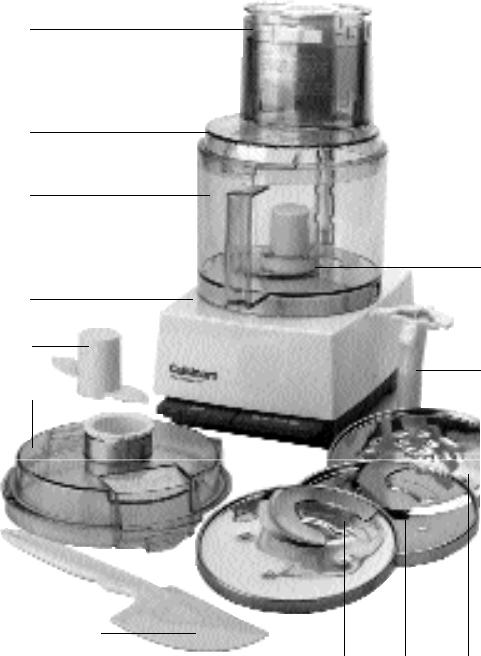
T H E P A R T S
2
4
3
2
6
1
7
10
5
11
8 |
8 |
9 |
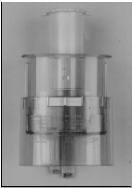
Your Cuisinart® Pro Custom 11™ Food Processor is a compact and versatile appliance that chops, minces, shreds, grates, slices, blends, purées, emulsifies, mixes and kneads - all with great efficiency and speed. The large feed tube allows you to make whole slices of large fruits and vegetables like potatoes, tomatoes and apples.
The machine includes:
l.Motor base with a vertically projecting shaft and two large control levers.
2 Work bowl.
3.Cover with a large feed tube.
4.Pusher assembly that slides over the feed tube.
5.Compact cover with cap for chopping/baking.
6.Sharp metal chopping/ mixing blade.
7.Plastic dough blade.
8.Two serrated slicing discs: 1 medium and 1 thin.
9.Shredding disc.
10.Detachable stem that fits all discs.
11.Plastic spatula.
T h e metal blade chops raw and cooked fruits, vegetables, meat, fish and cheese to the exact consistency you want - from coarse to fine, even to a purée. You control the texture . It chops nuts, makes nut butters, mayonnaise and sauces, and mixes t e n d e r, flaky pastry. The metal blade also mixes cakes, frosting, cookies, quick breads, muffins and biscuits.
The dough blade mixes and kneads m o re efficiently than the metal blade when your recipe calls for more than 3-1/2 cups (875 mL) of flour.
A locking device prevents heavy dough from driving the blade up on the shaft.
The standard slicing disc makes beautiful whole slices. It slices whole fruits and vegetables, cooked meat, semi-frozen raw meat and thin loaves of bread.
The thin slicing disc is perfect for slicing cabbage, onions, radishes, mushrooms, celery, potatoes and cucumbers.
The medium shredding disc processes most firm and hard cheese into long, attractive shreds. It also shreds vegetables like potatoes, carrots and zucchini, and processes nuts and chocolate to a grated texture.
The detachable stem fits all discs, making storage easy in limited space.
3
The pusher assembly has 3 parts.
1.The small removable white pusher fits into the small feed tube. This tube is for narrow food like carrots, for adding liquid, and for continuous feeding of small hard food like garlic.
2.The large pusher is permanently attached to the sleeve, but moves freely within it – except when the slide lock on the sleeve is locked in place over the large feed tube.
3.The bottom sleeve has two descending tabs. One locks the sleeve to the work bowl (white lock); the other pushes down an activating rod at the back
of the bowl, permitting the motor to start.

P R A C T I C I N G W I T H F O O D
4
PICK UP 4 COLOR PHOTOS
FROM FILM
PICK UP 4 COLOR PHOTOS
FROM FILM
PICK UP 4 COLOR PHOTOS
FROM FILM
Try chopping some practice foods b e f o re you process food to eat.
A zucchini or potato is a good choice. First cut into 1-inch
p i e c e s .
Insert the metal blade and put the pieces in the work bowl.
Put on the cover; press the pusher assembly down to lock it into place. Press and release the OFF/PULSE lever two or thre e times and see what happens. Each time the blade stops, let the pieces drop to the bottom of the bowl before you pulse again.
That puts them in the path of the blade each time the motor start s .
Using the pulse/chopping technique, you can get an even chop without danger of over-
p rocessing. Check the texture
f requently by looking through the cover of the work bowl. If you want a finer chop, press and release the OFF/PULSE lever until you achieve the desired texture. Onions and other food with a high water content will quickly end up as a purée unless examined
t h rough the work bowl after each pulse to make sure they are not overprocessed.
Try chopping other food, like meat for hamburger or sausage. Then make mayonnaise, pastry or
b read, as described in the recipes in this book. To obtain consistent results:
© Be sure all the pieces you add to the bowl are about the same size.
© Be sure the amount you p rocess is no larger than
recommended. (See page 26).

R E M O V I N G P R O C E S S E D F O O D
5
Before you do anything, wait for the blade to stop spinning.
Once it does, remove the cover first. You can remove the cover and pusher assembly in one operation. Hold the pusher assembly with your fingers away from the descending tabs and turn it clockwise. Lift it off, and the cover will come with it.
Never try to remove the cover and the work bowl together; this may damage the work bowl.
Always remove the bowl from the base of the machine before removing the blade, as the blade creates a seal to prevent food
from leaking. Turn the bowl clockwise to unlock it from the base, and lift it straight up to remove.
To prevent the blade from falling out of the work bowl onto your hand, use one of the three methods shown. Be sure your hands are dry. Remove the metal blade before tilting the bowl (1.), using a spatula to scrape off
any food. Or insert your finger through the hole in the bottom of the work bowl, gripping the blade from the bottom, and grip the outside of the work bowl with your thumb (2.). Or hold the blade in place with your finger
or a spatula while pouring out processed food (3.).
PICK UP 4 COLOR PHOTOS
FROM FILM
PICK UP 4 COLOR PHOTOS |
|
PICK UP 4 COLOR PHOTOS |
FROM FILM |
|
FROM FILM |
|
|
|
1 |
2 |
PICK UP 4 COLOR PHOTOS
FROM FILM
3

C H O P P I N G A N D P U R É E I N G W I T H T H E M E T A L B L A D E
6
To chop raw fruits and vegetables
Cut the food into 1-inch pieces. You get a more even chop when all pieces are about the same size.
Put no more than the recommended amount of food into the work bowl. (See page 26). Lock the cover in place. Press the OFF/PULSE lever at the rate of 1 second on, 1 second off until the food is coarsely chopped. Then hold down the OFF/PULSE lever, letting the machine run continuously until the food is chopped. Check
f requently to avoid overpro c e s s i n g . Use the spatula to scrape down any pieces that stick to the sides.
To purée fruit and cooked vegetables
Cut the food into 1-inch pieces. You get a smoother purée faster when all pieces are about equal in size. Put no more than the recommended amount of food
in the work bowl. (See page 26). Lock the cover in place. Pulse to chop coarsely, then press the ON lever and process continuously until the food is puréed. (NOTE: Cooked potatoes are an exception to this procedure. They develop a gluey texture when processed with the metal blade. See the recipe for mashed potatoes at the end of the book.)
© When making soup, you will want to purée vegetables that have cooked in liquid. Don’t add the liquid to the work bowl - just the cooked vegetables;
PICK UP 4 COLOR PHOTOS FROM FILM
PICK UP 4 COLOR PHOTOS FROM FILM
remove them with a slotted spoon. They will purée faster and smoother without liquid. Then add just enough liquid to make the purée pourable, return it to the soup liquid and stir to combine.
© Occasionally, a piece of food may become wedged between the blade and the work bowl.
If this happens, remove the cover, lift the blade out carefully and
remove the wedged piece. Empty the bowl, reinsert the blade and lock the cover into place, first removing the small pusher. Press the ON lever and drop the food pieces through the small feed tube while the machine is running. After adding a cupful this way, add the remaining food to the bowl
and process in the usual way.
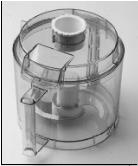
7
To chop hard food like garlic, hard cheese
Small foods like garlic can be dropped in whole. Larger foods like hard cheese should be cut into 1-inch pieces. Remove the small pusher, press the ON lever and drop the food through the small feed tube while the machine is running.
This method of processing minces garlic, shallots and onions. Hard cheese and coconut will have the same texture as if they had been hand grated.
I M P O RTA N T: Never try to process cheese that is too hard to cut with a knife. You may damage the blade or the machine.
To chop parsley and other fresh herbs
The herbs, the work bowl and the metal blade must all be thorough- l y clean and dry. Remove stems from herbs. Add leaves to bowl and process until they are chopped as fine as you want. The more herbs you chop at a time, the finer chop you can obtain. If completely dry when chopped, parsley and other herbs will keep for at least 10 days, stored in an airtight bag in the refrigerator. They may be frozen for months, stored in an airtight container or bag.
To chop peel from citrus fruit (zest) or to chop sticky fruit like dates or raisins
For citrus, remove only the peel (zest) with a vegetable peeler. Do not remove the white pith, which is bitter tasting. Cut the peel into lengths of 2 inches or less and
p rocess with 1/2 cup of granulated sugar from the recipe until finely chopped. This may take 2 minutes or longer.
For sticky fruit like dates, raisins, prunes and candied fruit, first freeze the fruit for about 10 minutes. Add to it some of the flour called for in the recipe. Use no more than 1 cup of flour for each cup of fruit.
COMPACT FLAT COVER
Use the Compact Cover for added convenience when your recipe calls for chopping, mixing, puréeing and kneading. It is particularly useful when you are preparing baked goods such as cakes, cookies, pies and breads.
To assemble the Compact Cover
Begin with the work bowl and the metal blade or dough blade in place. Place the Compact Cover on the work bowl so that the
Cuisinart logo written on the cover is face up and readable. Then turn cover COUNTERCLOCKWISE to lock into place.
Make sure the small cap is in place before using.
To disassemble the Compact Cover:
Place one hand near the Cuisinart logo and one hand on opposite end of cover; turn cover CLOCKWISE. Lift cover up
and off work bowl. Do not use the Compact Cover with any of the slicing or shredding discs.

C H O P P I N G A N D P U R É E I N G W I T H T H E M E T A L B L A D E
8
To chop meat, poultry, fish and seafood
The food should be very cold, but not frozen. Cut it into 1-inch pieces to ensure an even chop. Process no more than the recommended amount at a time. (See page 26). Press the OFF/PULSE lever 3 or 4 times at a rate of 1 second on, 1 second off. If the food is not chopped fine enough, let the processor run continuously for a few seconds. Check the texture often to avoid overprocessing. Use a spatula to scrape food from the sides of the bowl as necessary.
To purée meat, poultry, fish and seafood
Prepare the food as described above. Pulse until it is evenly chopped, then process continuously to the desired texture. Scrape the bowl
with a spatula as needed.
Leave the purée in the work bowl and add eggs, cream and seasonings as called for by the recipe. Process to combine thoroughly.
PICK UP 4 COLOR PHOTOS FROM FILM
PICK UP 4 COLOR PHOTOS FROM FILM
Remember you control texture by the length of time you process.

9
To chop nuts
Chop no more than the recommended amount at one time. (See page 26). Press and release the OFF/PULSE lever and check frequently to avoid letting powdered nuts clump together in a nut butter.
When a recipe calls for flour or sugar, add some to the nuts before you chop them— about 1/2 cup for each cup of nuts. This allows you to chop the nuts as fine as you want without turning them into a nut butter.
You can also chop nuts with a shredding disc. The optional Fine Shredding Disc is particularly good.
PICK UP 4 COLOR PHOTOS
FROM FILM
To make peanut butter and other nut butters
Process up to the recommended amount of nuts. (See page 26). Let the machine run continuously. After 2 or 3 minutes, the ground nuts will form a ball that will gradually smooth out. Scrape the sides of the bowl and continue processing until drops of oil are visible. Taste for consistency. The longer you process, the softer the butter will be. For chunk style, add a handful of nuts just after the ball of nut butter begins to smooth out. To make cashew butter, add a little bland vegetable oil. Processor nut butters contain no preservatives. Store in the refrigerator to keep them from separating.
To make flavored butter, spreads and dips
Cut room-temperature butter into tablespoon size pieces and reserve. Process flavoring ingredients first—anchovies, cheese, herbs, etc.—chopping them fine. Be sure the work bowl is clean and dry. Then add small hard ingredients like garlic and hard cheese through the feed
tube while the machine is running. Next, add the butter pieces and process until smooth. Add any liquid ingredients last, while the processor is running, and process just long enough to blend. Process ingredients for
s p reads and dips in the same way. All ingredients should be at room temperature and cut into 1-inch cubes, or added by tablespoonfuls.
PICK UP 4 COLOR PHOTOS |
|
PICK UP 4 COLOR PHOTOS |
FROM FILM |
|
FROM FILM |
|
|
|

T E C H N I Q U E S F O R C H O P P I N G A N D
P U R É E I N G W I T H T H E M E T A L B L A D E
10
To make mayonnaise
You can make foolproof homemade mayonnaise with your Pro Custom 11™. The work bowl and metal blade must be clean and dry.
Foods prepared with raw eggs may contain salmonella or other potentially harmful bacteria. Because egg yolks are a fine growth medium for bacteria, we recommend that you cook them for use in mayonnaise, Hollandaise sauce, Caesar salad dressing, chilled soufflés, chilled chiffons, mousses and other recipes calling for raw egg yolks. For mayonnaise, we recommend using either the “cooked egg” mayonnaise on page 38, or using the following method with pasteurized liquid eggs.
For a “one egg” batch of basic mayonnaise made with pasteurized liquid eggs, place 1/4 cup pasteurized liquid eggs, 2 tablespoons wine vinegar or lemon juice, 1 teaspoon dry mustard, 1/2 teaspoon kosher salt and a pinch of ground white pepper in the work bowl. With the machine running, add 1/2 cup of vegetable oil to the small pusher and allow to slowly drip into the mixture while processing. After all the oil has dripped through, add another 1/2 cup of vegetable oil to the small pusher and allow to drip through. The mixture will form a thick emulsion. For variation, you may experiment with using flavored vinegars, adding chopped fresh herbs, dry herbs, or roasted garlic to taste. To make your mayonnaise a little lighter, add some well-drained plain fat-free yogurt to taste.
To beat egg whites
The work bowl and metal blade must be absolutely clean.
Add 3 or more egg whites and p ress the ON lever. Add about 1 teaspoon of lemon juice or vinegar for every egg white. Vinegar makes stiffer whites; its flavor is hardly detectable in cakes or soufflés. Continue p rocessing until the egg whites
hold their shape - about 1-1/2 to 2-1/2 minutes.
Egg whites may be folded into batters and baked. We do not recommend serving uncooked egg whites.
PICK UP 4 COLOR PHOTOS FROM FILM
To whip cream
P rocessor whipped cream holds its shape very well. It is good for decoration or as a topping for
gingerbread, berries and other desserts.
Chill the cream well before starting. Using the Metal blade process continuously until it begins to thicken; add sugar as desired and continue processing. Watch carefully until the cream reaches the desired consistency. For consistently reliable results, add 2 tablespoons of non-fat dried milk for every cup of cream, before whipping.
P rocessor whipped cream does not whip to the light, fluffy consistency obtained by methods that beat in more air. Use the optional Whisk Attachment for the fluffiest whipped cream.
To make bread, cracker and cookie crumbs and crumb cru s t s
Cut or break bread, crackers or cookies into 1-inch pieces and put them in the work bowl.
Process continuously until they reach the desired texture. For seasoned crumbs, chop parsley or other fresh herbs with the crumbs. For buttered crumbs, process until the dry crumbs are of the desired texture, then dribble melted butter through the small feed tube while the machine is running.
For crumb crusts, process crackers or cookies as described above. Add sugar, spices and butter, cut into 1-inch pieces,
as specified by your recipe. Process until well combined.
To make pastry
This describes the general
procedure. A recipe giving exact proportions is on page 39.
Combine unbleached all-purpose flour, salt and 1-inch pieces of very cold butter in the work bowl. Process to the consistency of cornmeal. While the machine is running, pour ice water through the feed tube. Stop processing as soon as the dough begins to form a ball, to ensure tender, flaky pastry. Use the dough immediately or form it into a round disc about
1 inch thick. Wrap it in plastic wrap and refrigerate or freeze for later use.
To make quick breads, and cakes that use baking powder and/or soda.
The most important rule for success is not to overmix after the flour is added.
The ingredients for these soft doughs should be cold. If the recipe calls for chopped ingredients like lemon peel or nuts, chop them first while
the work bowl is clean and dry. Then set them aside until needed. (Always use sugar when chopping lemon peel; see page 7.)
Put dry ingredients like flour, salt and leavening in the work bowl and process with the metal blade for 5 seconds to mix them. Remove and reserve the dry ingredients.
Add the eggs and sugar to the work bowl and process to mix, letting the machine run about 1 minute. Next, add 1-inch pieces of butter, at room temperature.
Let the machine run continuously for a minute, until the butter is thoroughly mixed with the sugar and eggs. Then add flavoring and
11
liquid – vanilla, spices, cocoa, etc. Process until mixed. Add the dry ingredients to the work bowl.
Process by pulsing, inspecting after each pulse. Stop pulsing as soon as the dry ingredients have almost disappeared into the batter. Overprocessing will cause quick breads and cakes to be tough. (If your recipe calls for ingredients that are to be coarsely chopped - like raisins or nuts - add them last with the mixed dry ingredients.)
To make cake mix
Your food processor work bowl i s l a rge enough for the pre p a r a t i o n of an 18.5-ounce packaged cake mix.
Insert the metal blade and add the cake mix to the work bowl. While the machine is running, add the eggs and liquid through the small feed tube and process for 5 seconds. Scrape down the side of the work bowl and process again for 1 minute for maximum volume. Remove the work bowl from the base but do not remove the metal blade. Insert your finger into the underside of the blade from
the bottom of the work bowl to hold the blade in place while emptying the batter.
Tip:
After emptying cake batter or puréed soup from the work bowl, replace the bowl on the motor base. Insert the metal blade and pulse once. Centrifugal force will spin the batter off the blade onto the side of the work bowl. Remove the blade, and use the spatula to scrape any remaining batter from the bowl.
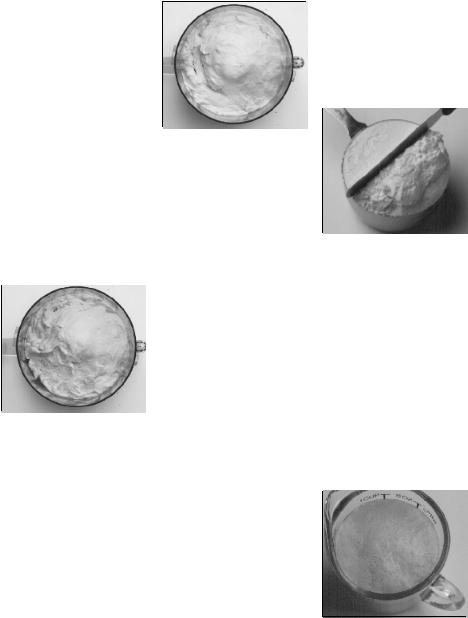
T E C H N I Q U E S F O R K N E A D I N G Y E A S T D O U G H W I T H T H E D O U G H B L A D E
12
The Pro Custom 11™ Food Processor can mix and knead dough in a fraction of the time it takes to do it by hand. You will get perfect results every time if you follow these directions. NEVER TRY TO PROCESS DOUGH THAT IS TOO STIFF
TO KNEAD COMFORTABLY BY HAND.
There are two general types of yeast dough.
1. Typical bread dough is made with a flour mix that contains
at least 50% white flour. It is uniformly soft, pliable and slightly sticky when properly kneaded. It always cleans the inside of the work bowl completely when properly kneaded.
2. Typical sweet dough contains a higher proportion of sugar, butter and/or eggs than typical bread dough. It is rich and sticky, and it does not clean the inside of the work bowl. It requires less kneading after the ingredients are mixed. Although 30 seconds is usually sufficient, 60 to 90 seconds gives better results if the machine does not slow down. Except for kneading, described below, the processing procedures are the same for both types
of dough.
Machine capacity
Typical bread dough:
5 cups all-purpose flour
3 cups whole-grain flour
Typical sweet dough:
3 1/2 cups all-purpose flour
If a bread dough recipe calls
for more than the recommended amount of flour, mix and knead it in equal batches.
Using the right blade
Use the plastic dough blade when the recipe calls for more than 3-1/2 cups of flour. Use the metal blade when a recipe calls for less than 3-1/2 cups of flour. Because the dough blade does not extend to the outside rim of the work bowl, it cannot pick up all the flour when small amounts are processed.
Whichever blade you use, always push it down as far as it will go on the motor shaft.
Measuring the flour
It’s best to weigh it. If you don’t have a scale, or the recipe doesn’t specify weight, measure by the “stir, scoop and sweep” method. Use a standard, graduated dry measure, not a cup for liquid ingredients.
With a spoon or fork, s t i r the flour in its container. With the dry
measure, s c o o p up the flour so it o v e rflows. With a spatula, knife or chopstick— being careful not to
p ress down — s w e e p excess flour back into the container so the top of the measure is level.
Proofing the yeast
The expiration date is marked on the packages. To be sure your yeast is active, dissolve it in a small amount of warm liquid (about 1/3 cup for one package of dry yeast). The temperature of liquids used to dissolve and activate yeast must be between 105°F and 120°F. Yeast cells a re not activated at temperatures lower than this, and they die when exposed to temperatures higher than 130°F. If the recipe includes a sweetener like sugar or honey, add a tablespoon with the yeast. If no sweetener is called for, add a pinch.
The yeast won’t foam without it.
Let the mixture stand until it foams —up to 10 minu t e s .
Processing dry ingredients
Put the flour and other dry ingredients in the work bowl. If the recipe calls for herbs, oil or solid fats like butter, add them with the flour. Turn the machine on, and let it run for about
20 seconds.
Adding liquids
All liquid should be added through the feed tube while the machine is running. Add liquid in a slow, steady stream, only as fast as dry ingredients absorb it. If liquid sloshes or splatters, stop adding it but do not turn off machine. Wait until ingredients in bowl have mixed,
then add remaining liquid slowly. Pour liquid onto dough as it passes under feed tube opening. Do not pour liquid directly onto bottom of bowl.
Follow the recipe carefully. It is important to add enough liquid to make the dough soft enough to knead. Kneading dough that is too stiff can strain the machine.
All liquid except that used to activate yeast should be cold, to minimize the possibility of overheating the dough. You must never knead a yeast dough to a temperature higher than 100°F. Doing so will slow or even prevent the action of the yeast.
Kneading bread dough
Do not try to use the machine to knead dough that is too stiff to knead comfortably by hand. Doing so can strain the machine.
Kneading typical bread dough
After the dough starts to clean the inside of the work bowl completely and forms a ball, process it for 60 seconds to knead it. Stop the machine and test the dough to be sure it’s properly kneaded. Typical bread dough should have a soft, pliable texture and it should feel slightly sticky. Stretch the dough with your hands to test it. If it feels hard, lumpy or uneven, continue processing until it feels uniformly soft and pliable. Make sure that the blade is firmly pressed back into place after removing the dough to test it.
Kneading typical sweet dough
Process dough for at least 30 seconds after all the ingredients are incorporated. It will not clean the inside of the work bowl. If necessary, scrape the bowl and process for 5 more seconds.
Adding other ingredients
Cheese, nuts and raisins may be added with the dry ingredients or during the final kneading. To leave them almost whole, add them through the feed tube 5 seconds before you stop kneading. For a finer texture, add them with the dry ingredients.
Rising
Put the dough in a large, lightly floured plastic food storage bag. Squeeze out all the air and close the bag, allowing space for the dough to rise. Or put the ball of dough in a large bowl coated with soft butter or vegetable oil. Roll the dough around to coat its entire surface. Cover it with a
13
damp towel or a piece of oiled plastic wrap.
Let it rise in a warm, draft-free place — about 80°F. The rising time is usually about 1-1/2 hours but will vary from 45 minutes to several hours, depending on the type of flour and the humidity of the air. To test if the dough has risen enough, stick your finger in it. An indentation should remain. If it doesn’t, let the dough rise more and test again. When it has risen enough, punch the dough down. It is now ready to shape.
Shaping, finishing and baking
If you shape the dough in loaf pans, coat them with vegetable oil cooking spray and fill them only half full. Let rise until dough is just slightly above the top of the pan. If shaping free-form loaves, let them rise on an oiled baking sheet until at least doubled in bulk.
Making consecutive batches
You can make several batches of bread dough in a row.
The motor in the Pro Custom 11™ Food Processor is extremely efficient. Follow the recipe for White Bread, pg. 41.
